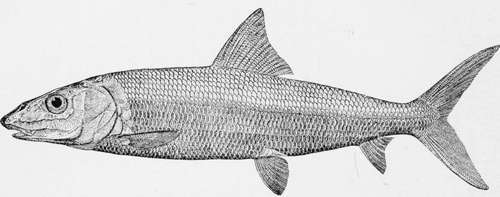The Lady-Fish Or Bone Fish-Albula Vulpes (Goode), Albula Conoryhnchus (Gunther)
Description
This section is from the book "American Game Fishes", by W. A. Perry. Also available from Amazon: American Game Fishes: Their Habits, Habitat, and Peculiarities; How, When, and Where to Angle for Them.
The Lady-Fish Or Bone Fish-Albula Vulpes (Goode), Albula Conoryhnchus (Gunther)
Pectoral falcate, longer than head. Breast naked, with a small patch of scales in front of ventrals only. Caudal lobes equal. Head 3½; depth 2½; Lat. I. (scutes) about 30. D. VIII-I, 20; A. II-I, 17. "Cape Cod to West Indies, common southward."
But a single species known, according to Jordan and Gilbert, and found in all warm seas, and very extensively distributed-in the West Indies, the coasts of North and South America, the Indian Ocean, the Red Sea, and on the coast of Japan, according to Professor Goode.
In the Bermudas it is considered good eating, but on the Florida coast it seems to be a mass of bones and fat. To the angler, however, the Ladyfish affords more sport than any other species on the southern coast.
No sooner is it hooked, than it begins to throw itself from the water in successive and lofty leaps, then darting round and round the boat, under it and over it, till exhausted, or until it escapes by casting out the hook, or cutting the line with its sharp labials. The mouth being tender, the hook does not take a firm hold, and one-half of the number hooked usually escape. I know of no fish which equals it in activity; even the Grilse, or the Land-locked Salmon make fewer leaps and are less active in play. Like the Cavalli, it makes its appearance with the first warm weather, in schools, feeding both at the bottom and on the surface and readily takes fly or spoon. It preys voraciously on Mullet, Menhaden and other small fishes, often driving them on shore. It is a slender and handsomely formed fish, built for speed, with a high dorsal fin, and deeply forked tail. Weight from two to four pounds, but pulls like a six-pounder.

Lady-Fish or Bone-Fish- Albula vulpes.
Description of Lady-fish-Albula Vulpes (Goode), - [from a freshly-caught specimen.] Body slender and cylindrical. Head one-fifth the whole length. Eyes very large, fins yellow. Mouth large, teeth small; labials long and large, with fine teeth on edges. Scales small. Fins all soft-rayed, dorsal high, in middle of back; 18; pectoral 16; anal 10; tail deeply forked. Color of head greenish, back dark blue, sides and belly silvery. Length one to three feet.
Continue to:
- prev: The Cavalli Or Crevalle-Caranx Hippus (Gunther)
- Table of Contents
- next: Fly-Fishing In Salt-Water
